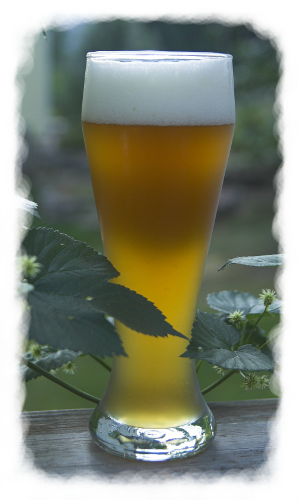Difference between revisions of "Weissbier Hell"
(→Grist) |
(→Water) |
||
| Line 19: | Line 19: | ||
Here is a simple water recipe for brewers who build their own water: | Here is a simple water recipe for brewers who build their own water: | ||
| − | 30L (assuming 25L (6.25 gal) pre-boil volume) reverse osmosis water + | + | * 30L (assuming 25L (6.25 gal) pre-boil volume) reverse osmosis water + |
| − | 3.0g gypsum (CaSO<sub>4</sub> 2H<sub>2</sub>O) | + | * 3.0g gypsum (CaSO<sub>4</sub> 2H<sub>2</sub>O) |
| − | 2.4g calcium chloride (CaCl 2H<sub>2</sub>O) | + | * 2.4g calcium chloride (CaCl 2H<sub>2</sub>O) |
(50 mg/L Ca; 0 mg/L Mg; 0 mg/L Na; 57 mg/L SO4; 43 mg/L Cl; 0 mg/L HCO3) | (50 mg/L Ca; 0 mg/L Mg; 0 mg/L Na; 57 mg/L SO4; 43 mg/L Cl; 0 mg/L HCO3) | ||
| − | You may also use a [[Various_water_recipes#Brewing_school_Weihenstephan_water|water recipe]] that mimics the water at the brewing school Weihenstephan. | + | You may also use a [[Various_water_recipes#Brewing_school_Weihenstephan_water|water recipe]] that mimics the water at the brewing school Weihenstephan. |
= Grist = | = Grist = | ||
Revision as of 02:44, 9 July 2010
|
One of the most enjoyable beers in the summer time is a good Weissbier. Here is a basic recipe that I enjoy brewing at least once or twice per year. This type of beer is also known as Hefeweizen or Weizenbier. However, when though Weissbier and Weizenbier look similar their names stem from different characteristics of the beer. Weissbier refers to the "white" color of the beer even though the dark variety is also called Weissbier. But instead of being "Weissbier Hell" (german for light) they would be "Weissbier Dunkel" (dunkel means dark). Outside southern Germany those beers are called Weizenbier or Hefeweizen which refers to the fact that they are brewed with wheat (Weizen in German) and oftentimes also contain yeast (Hefe in German). In order to be called a Weissbier or Hefeweizen in Germany the grist has to contain at least 50% wheat. Wheat is allowed in German brewing only when a top fermenting yeast is used. Bottom fermented beers are brewed exclusively from barley malt. While Weissbiers derive their characteristic from flavors that are considered off-flavors in most other styles they are not necessarily easy to brew well. Mostly because a good Weissbier needs to show a balance between these flavors.
Contents[hide]WaterThe water for a Weissbier Hell should be soft and have a residual alkalinity of 0. Here is a simple water recipe for brewers who build their own water:
(50 mg/L Ca; 0 mg/L Mg; 0 mg/L Na; 57 mg/L SO4; 43 mg/L Cl; 0 mg/L HCO3) You may also use a water recipe that mimics the water at the brewing school Weihenstephan. Grist
HopsOne addition of German hops worth about 40 mg/l alpha acid in the kettle full wort. This is about 1 g alpha acid in 25 l (6.6 gal) or 10 g 10% alpha acid hops in 25 l. The hops may be added before or after the wort comes to a boil. Boil time is 70 min. YeastWyeast 3068, propagated to yield about 50-70 g loose yeast slurry. Mash[[Infusion_Mashing#Hochkurz_Mash]|Hochkurz Mash]]: Use a mash thickness of about 4 l/kg or 2 qt/lb. If you are using a hot water infusion to move from the maltose rest to the dextrinization rest aim for that mash thickness at the dextrinizaton rest. The mash out can be skipped if reaching it is too difficult.
An alternate mash option is the addition of a ferulic acid rest at 45 C (113 F) for 45 min. This rest emphasizes the ferulic acid esterase which increases the ferulic acid content of the wort. This ferulic acid, which is present in both wheat and barley malt, is converted to 4-Vinylguaiacol (4VG) by the Weissbier yeast. 4VG gives the beer the clove flavor and aroma. If this rest is used the acidulated malt should be added once the Maltose rest temp is reached since the ferulic acid esterase has a pH optimum that is above 5.7. The higher pH also limits the activity of the protoelytic enzymes. But even without this rest I have been able to brew great Weissbiers that have a lot of the characteristic clove flavor and most of the time I use the aforementioned Hochkurz mash. This mash can be conducted as a decoction, infusion or direct heated step mash. BoilAdd hops after 10 min boil and boil for another 60 min. Chill to pitching temperature of 17 *C (64 *F). Keep about 2L of the wort (freeze in soda bottle) Primary fermentationFerment at 17 - 19 *C (63 - 67 *F) until fermentation is complete. Perform fast ferment test to determine limit of attenuation or use other means to ensure complete fermentation.
Aging/Lagering |



